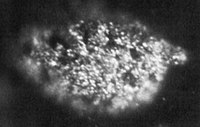
Photo from wikipedia
Abstract Because of its excellent safety and sustainability, spinel-structured lithium titanate (LTO, Li4Ti5O12) has recently attracted intensive attention as a promising anode material for lithium-ion batteries (LIBs) for large-scale applications.… Click to show full abstract
Abstract Because of its excellent safety and sustainability, spinel-structured lithium titanate (LTO, Li4Ti5O12) has recently attracted intensive attention as a promising anode material for lithium-ion batteries (LIBs) for large-scale applications. However, several obstacles impede the use of LTO in practical applications, including its high cost and relatively low capacity due to poor electron conductivity. To reduce the synthesis cost and increase the efficiency of LTO, LTO microspheres assembled with nanoparticles were prepared from a titanium(IV) oxysulfate (TiOSO4) solution, which is generally produced during the sulfate process in titanium mining of ilmenite (FeTiO3). Before LTO microspheres were synthesized, 1–2 μm microsphere scaffolds consisting of TiO2 nanoparticles were prepared through the urea-based hydrolysis of TiOSO4. The LTO microspheres were obtained through a sequential hydrothermal reaction–calcination process using LiOH and the as-prepared TiO2 microsphere scaffolds. According to the synthesis conditions, LTO–TiO2 (LTO-500), nonporous LTO (LTO-800), and porous LTO (LTO-HT3-500) microspheres were synthesized. The electrochemical performances of the synthesized LTO microspheres were most strongly affected by the microspheres’ crystal size and surface area. The presence of TiO2 in the LTO microspheres also affected their performance. The LTO-HT3-500 microspheres (pure spinel LTO phase) showed an excellent initial discharge capacity of 158.7 mAh/g, superior cyclic ability (
Journal Title: Journal of Alloys and Compounds
Year Published: 2020
Link to full text (if available)
Share on Social Media: Sign Up to like & get
recommendations!